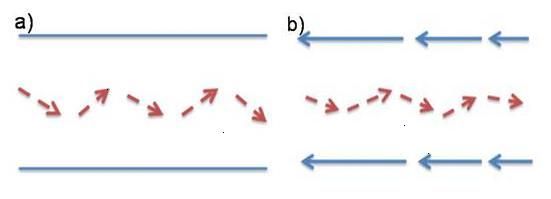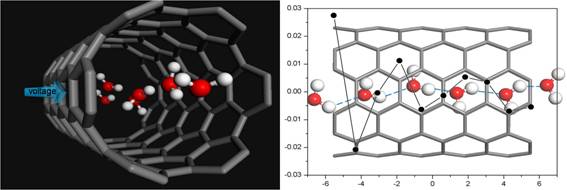- Home >> News >> Research Progress
Research Progress
Research progress on hydroelectric voltage generation based onwater-filled single-walled carbon nanotubes
Supported by the National Nature Science Foundation of China (NSFC), the Ministry of Science and Technology of the People’s Republic of China (MOST) and the Chinese Academy of Sciences (CAS), the "Micro/NanoSystem Mechanics and Physical Mechanics Research Group" from the Institute of Mechanics, CAS, made remarkable progress in the study of hydroelectric voltage generation when water flows inside a single-walled carbon nanotubes (SWCNTs). The research results have been published on the recent issue in the Journal of the American Chemistry Society (JACS), whose SCI Impact Factor (IF) is 7.885. (Yuan QZ and Zhao YP). Hydroelectric voltage generation based on water-filled single-walled carbon nanotubes. Journal of the American Chemical Society, 131 (18): 6374-6376 (2009)).
With the fast development of in situ and real time nanotechnologies in the past decade, it is highly desired for nanoscale, wireless or implantable devices in the field of bio-sensing, bio-monitoring and bio-detecting to be self-powered. Nowadays, wireless and implantable bio-medical devices are battery poweredThis involves a serious limitation in terms of available power and analysis duration. Therefore, it is essential to explore innovative nanotechnologies for converting and collecting ambient energy into usable electric energy to power nano-devices without using battery. Researchers in and abroad (Ghosh, et al., Science, 2003; Zhao, et al, Adv. Mat., 2008) utilized CNTs to convert hydropower into electric power. But limited by experimental conditions, the mechanism of converting hydropower into electric power and phenomenon at atomic level are still unknown. However, before further applications, it’s necessary to figure out and understand the mechanism. Without a basic understanding of the mechanisms involved, it would be difficult to design an efficient nano power-cell or a nano power-harvesting technique.
Quanzi Yuan, a Ph.D. degree student, and his supervisor Prof. Ya-Pu Zhao from the Institute of Mechanics, CAS, investigated this urgent problem about self-powered nano devices. They simulated the flow of water in SWCNT, employing the mutual iterative method of density functional theory and molecular dynamics. They noticed that a voltage difference of 17.2 mV is induced when water molecules flows through SWCNTs (Figure 1). The electric field of the tube was 107 V/m. They found that the structure of water-filled SWCNT can use the interaction between water dipole chain and free carriers in SWCNT, harvesting hydropower in the environment and converting hydropower into electric power (Figure 2). Based on these results, Yuan and Zhao conclude that "the structure of a water-filled SWCNT" makes it "a promising candidate for a synthetic nanoscale power cell, as well as a practical nano-power harvesting device." The authors succeeded in figuring out the fundamental reason behind the voltage generation and identified the process as useful for real-world applications of the smallest hydroelectric power generator.
The referees from J. Am. Chem. Soc. highly evaluated this work: "This is generally a very good and very well written communication that addresses the fundamental mechanism driving voltage generation along single wall carbon nanotubes when immersed in a flowing polar liquid. Such fascinating effects have been observed experimentally (Ghosh, et al., 2003, and Zhao, et al., 2008). The topic is of keen fundamental interest, and may support development of practical nanopower harvesting devices. The authors describe very nicely done computational modeling work covering water filling, water orientation, fluid motion and charge transfer to the SWNT."
This work attracts attentions of many websites (www.nanovip.com, arstechnica.com, etc.) as soon as it has been published online.


